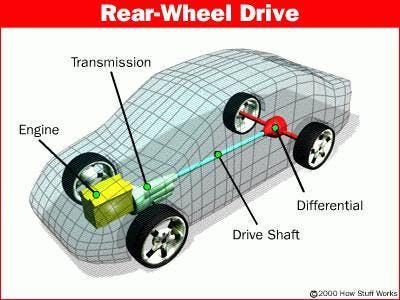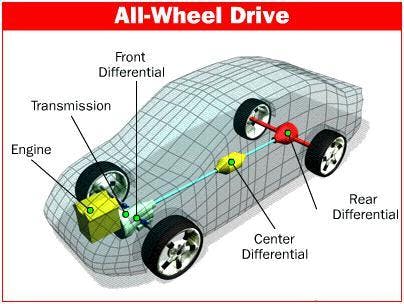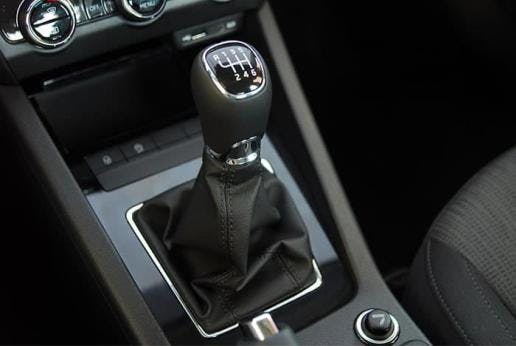Power Transmission System of Automobile
Md. Nayemur Rahman, ME (2020-21)
When we think of automobiles, we must wonder at the mechanics of rotating power transmission from engine to wheels. What exactly is a power transmission system, why is it important and how does it work? In this article, we will take a look at the different components of a power transmission system and how they work together to make our car move.
In simple words the power transmission system is the system that delivers engine power to the wheels, to make the car move. It is a complex system that consists of different components including clutch, driveshaft, gearbox, differential and axels. Don't worry, we will learn about each of them and how they work. Before we dive into our main topic, let's learn about 4 main types of drivetrain systems: front-wheel drive (FWD), rear-wheel drive (RWD), all-wheel drive (AWD), and four-wheel drive (4WD).
Front Wheel Drive
In FWD cars, the front wheels are powered by the engine, while the rear wheels are simply free-wheeling wheels.

Advantages
- Better fuel efficiency.
- More traction in snow and ice.
- Less expensive to produce.
Examples
- Toyota Camry.
- Mazda3.
- BMW X2.
Rear Wheel Drive
In RWD cars, the rear wheels are powered by the engine, while the front wheels are simply used for steering.

Advantages
Better performance.
Better handling.
More fun to drive.
Examples
BMW 3 Series
Mercedes-Benz C-Class
All Wheel Drive
In AWD, the power is distributed to all four wheels.

Advantages
Better traction in snow and ice.
Better handling.
More capable off-road than FWD and RWD.
Examples
Audi Q5.
BMW X3.
Mazda CX-5.
Four Wheel Drive
4WD is a type of drivetrain system that is similar to AWD, but it is designed for more off-road use.

Advantages
More capable off-road.
Better durability.
Examples
Jeep Wrangler
Toyota Tacoma
Ford F-150
Main Components of a Power Transmission System
Clutch

Many of you may have noticed that we need to press clutch paddle before changing gear of a car that has manual transmissions system. The clutch is a device which disengages the engine from transmission while changing gear. As we know internal combustion engine has a very limited torque band. So, in order to vary the speed of drive wheel by changing gear without interrupting the engine speed we need to disengage the engine form transmission. This is where the clutch comes in.
Gearbox
The gearbox is a system of gears that allows the driver to change the speed of the car without changing the engine speed. It does this by selecting different gear ratios, which change the amount of torque that is transmitted to the wheels. This allows the engine to operate at its most efficient speed, regardless of the vehicle's speed.
Propeller Shaft
At first, we have to know what a shaft is. A shaft is a rotating machine element, usually that has a circular cross section, which is used to transmit power from one part to another. In automobile it is used to transmit power from gearbox to differential.
Differential
Imagine two rear wheels connected with a single shaft. Now, while taking a turn, we know that the outer wheel must turn faster than the other wheel. If two wheels are connected with a single shaft, they will rotate at the same speed, and as a result, the wheel will slip. To avoid this, engineers introduced a set of gears that can ensure the independent rotation of each wheel. Now, each wheel can rotate at a different speed, and there is no more slipping. This set of gears is called a differential.
Axle
Axle is the one through which power is transmitted to the wheels from the differential. It can be either the front axle (in case of front wheel drive) or rear axle (in case of rear wheel drive). Axle can be two types: dead and live axle, but only live axle can transfer power.
Types of Power Transmission System
Manual
In manual transmission system the driver needs to change gear manually.

Advantages
- More fuel-efficient
- More control over the vehicle
- More durable
Automatic Transmission
Automatic transmissions shift gears automatically without any input from the driver.
Advantages
- More convenient to operate.
- Easier to drive in heavy traffic.
- Smoother shifting
Disadvantages
- Less control over the vehicle
- Less fuel-efficient
- Less durable
Power Transferred in Each Type of Drivetrain System
FWD: Engine > Transmission > Differential > Front axles.
RWD: Engine > Transmission > Driveshaft > Differential > Rear axles.
AWD: Engine > Transfer case > Front and rear axles.
4WD: Engine > Transfer case > Front and rear axles.
Maintaining the Power Transmission System
To keep a power transmission system running smoothly it’s important to maintain it properly. We should check the fluid levels, inspect the components and make any necessary repairs or replacements.
Some tips for maintaining the power transmission system:
- Change the transmission fluid regularly: The transmission fluid lubricates and cools the components of the transmission. Over time, the transmission fluid breaks down and loses its effectiveness.
- Check the clutch fluid level regularly: The clutch fluid is responsible for engaging and disengaging the clutch. A low clutch fluid level can cause the clutch to slip or not engage properly.
- Inspect the driveshaft for rust and corrosion: Rust and corrosion can weaken the driveshaft and cause it to fail.
- Warmup the car before driving in cold weather.
- Avoid hard acceleration and braking.
The automobile power transmission system is a complex and important system that allows rotating power to be transmitted from the engine to the wheels. The power transmission system consists of a number of different components, including the clutch, transmission, driveshaft, differential, and axles. Each component plays an important role in transferring power from the engine to the wheels. In this article, I have tried to provide an easy overview of this process, as it is a complex and large field to study.
